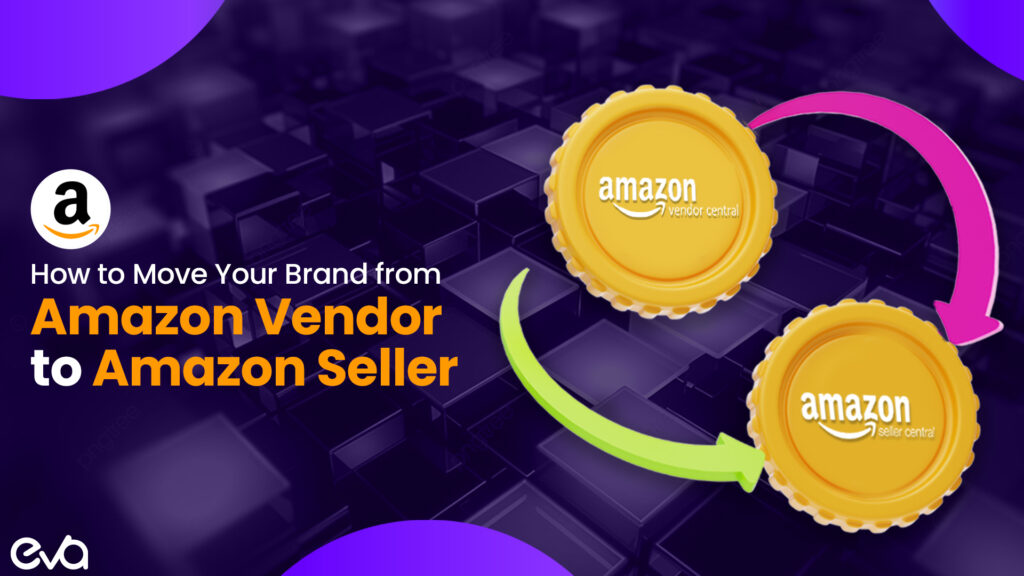Table of Contents
- Introduction
- Understanding the Difference Between Amazon Vendor (1P) and Amazon Seller (3P)
- Critical Differences Between 1P and 3P Models
- Why Transition from 1P to 3P?
- Steps to Move Your Brand from Amazon Vendor to Seller Central
- Transferring Your Product Listings and Data
- Handling Vendor Agreements and Communication with Amazon
- How Eva Can Help?
- Best Practices for a Smooth Transition
- Common Challenges When Moving from 1P to 3P
- Conclusion
- FAQs
Introduction
Amazon’s marketplace provides brands with two primary models for selling products: Amazon Vendor (1P) and Amazon Seller (3P).
While the vendor model offers convenience, it often limits brand control and profitability. Transitioning from Amazon Vendor (1P) to Amazon Seller (3P) is a transformative move that can unlock new growth opportunities, increase control over your brand, and boost profitability.
In this comprehensive guide, we will explore the steps, benefits, challenges, and strategies for seamlessly making this shift.
Whether you’re looking for Amazon Account Management support or Amazon Growth Strategy tips, this guide has everything you need to know.
Understanding the Difference Between Amazon Vendor (1P) and Amazon Seller (3P)
What is Amazon Vendor (1P)?
Amazon Vendor Central operates on a wholesale model. Brands sell their products directly to Amazon, which acts as the retailer. Here’s a deeper look at the pros and cons:
Advantages of Amazon Vendor (1P):
- Convenience: Amazon handles pricing, inventory management, and customer service.
- Retailer Relationships: Your brand benefits from being “sold by Amazon,” which can increase consumer trust.
- Simplified Logistics: All logistics, including shipping and returns, are managed by Amazon.
Disadvantages of Amazon Vendor (1P):
- Limited Control: Brands have no say over pricing, promotional strategies, or inventory reorders.
- Margin Erosion: Amazon typically demands high wholesale discounts, eating into profit margins.
- Vendor Dependency: Purchase orders can be unpredictable, leaving brands vulnerable to revenue fluctuations.
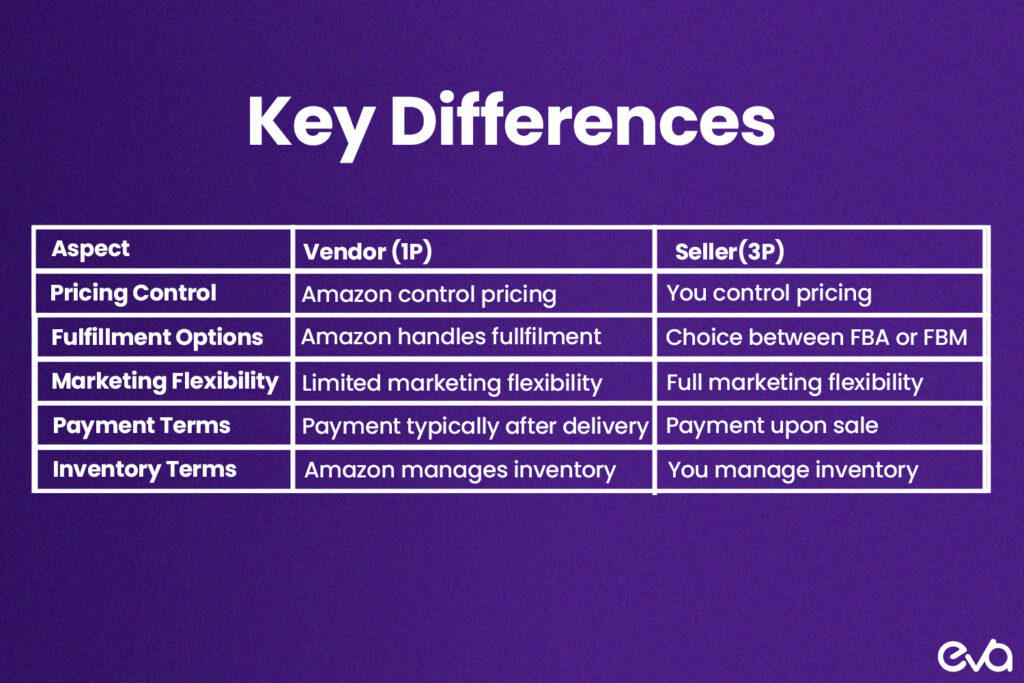
What is Amazon Seller (3P)?
Amazon Seller Central is designed for brands and individuals to sell directly to consumers via the Amazon marketplace. This model empowers brands to control their operations.
Advantages of Amazon Seller (3P):
- Pricing Freedom: Set and adjust your product prices as needed.
- Marketing Control: Create tailored advertising campaigns with Amazon PPC Management and other Amazon Advertising tools.
- Higher Margins: Sell products at retail prices without giving up wholesale discounts.
- Flexibility: Choose Fulfillment by Amazon (FBA) or Merchant (FBM).
Disadvantages of Amazon Seller (3P):
- Operational Responsibility: You manage inventory, customer service, and logistics if you choose FBM.
- Increased Complexity: Running an Amazon Seller account requires active management and optimization.
Critical Differences Between 1P and 3P Models
Feature Amazon Vendor (1P) Amazon Seller (3P)
Control Amazon controls pricing and inventory Sellers manage pricing and inventory.
Margins Wholesale discounts reduce profits The Direct-to-consumer model increases profits.
Marketing Limited promotional tools Full access to Amazon Marketing Services
Fulfillment Amazon handles logistics Choose between FBA or FBM
Why Transition from 1P to 3P?
Increased Control Over Pricing and Margins
One primary reason for shifting from vendor to seller is the ability to control pricing. With Amazon SEO Services and Amazon Listing Optimization, you can further enhance your profitability by ensuring your products rank high and attract traffic.
Greater Flexibility in Marketing and Promotions
As a 3P seller, you can use Amazon Advertising tools, such as Sponsored Products, Brands, and Amazon PPC Management.
This flexibility allows you to run targeted campaigns to drive sales and improve visibility.
Avoiding the Challenges of Vendor Central
Vendor Central often brings unpredictability, such as sudden changes in purchase orders or delayed payments.
Moving to Seller Central gives you autonomy and eliminates reliance on Amazon’s retail decisions.
Steps to Move Your Brand from Amazon Vendor to Seller Central
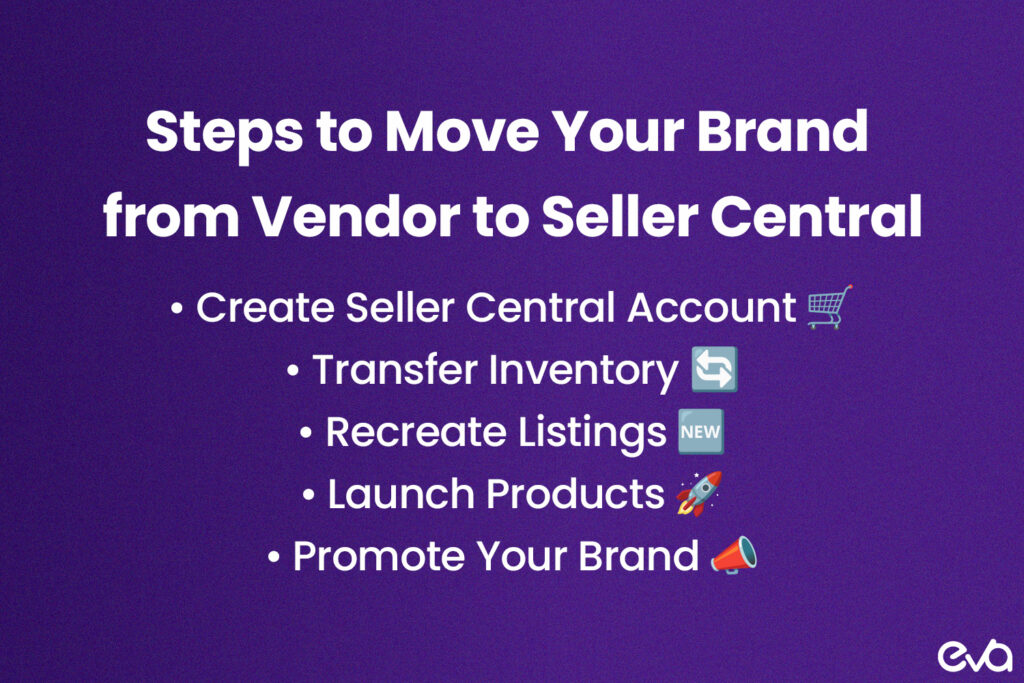
Step 1: Set Up Your Amazon Seller Central Account
Begin by registering your business on Amazon Seller Central. Ensure your account is categorized as a Professional Seller to access advanced tools like Amazon SEO Services and Amazon Brand Management.
Step 2: List Your Products in the Amazon Marketplace
Optimize your product listings with Amazon Listing Optimization techniques. To improve conversions, include high-quality images, SEO-optimized titles, bullet points, and descriptions.
Step 3: Manage Inventory and Fulfillment Options
Decide between using Fulfillment by Amazon (FBA) or Fulfillment by Merchant (FBM).
Using Fulfillment by Amazon (FBA):
- Amazon stores, packs, and ships your products.
- Eligible for Prime delivery, improving visibility.
- Amazon handles customer service and returns.
Using Fulfillment by Merchant (FBM):
- You maintain control over shipping and inventory.
- Suitable for brands with established logistics.
Transferring Your Product Listings and Data
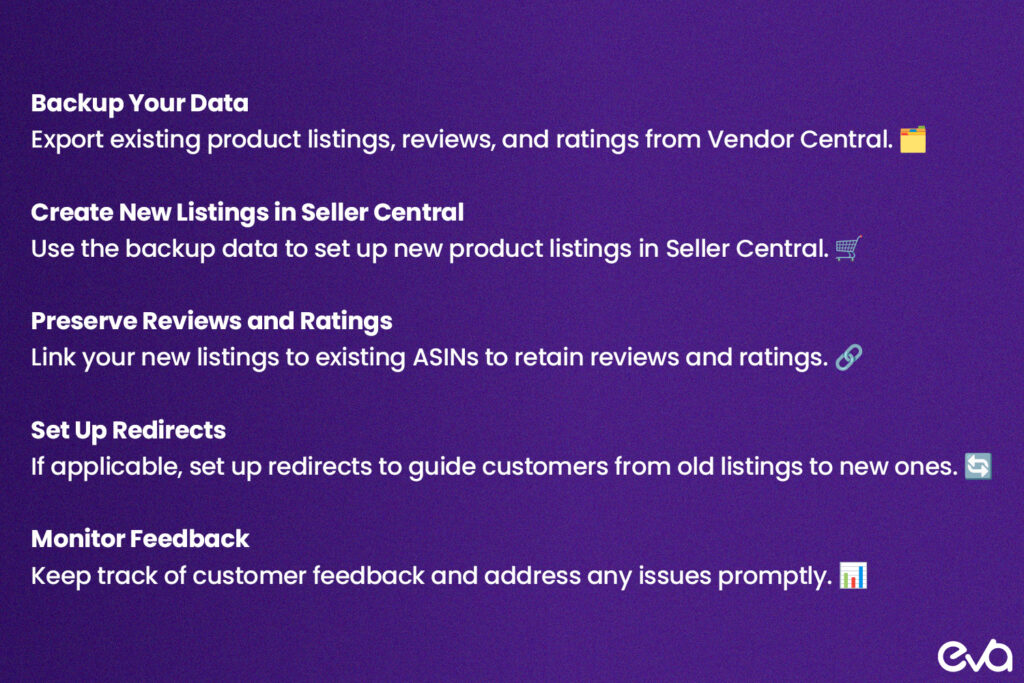
How to Transition Product Listings from Vendor Central to Seller Central
Export product data from Vendor Central and format it for Seller Central. Maintain SKU consistency for smooth data migration.
Maintaining Reviews and Ratings During the Transition
Link ASINs to ensure customer reviews and ratings remain intact. This is critical for sustaining credibility and visibility.
Handling Vendor Agreements and Communication with Amazon
Ending Your Vendor Agreement with Amazon
Notify Amazon of your decision to end the Vendor agreement. Provide sufficient notice and ensure all obligations are met.
Communicating with Your Vendor Manager
Maintain open and professional communication. A positive relationship ensures no disruptions during the Transition.
How Eva Can Help?
Eva is a leading eCommerce technology company dedicated to helping brands grow profitable on Amazon, Walmart, and other major marketplaces.
If you’re considering transitioning from Amazon Vendor (1P) to Amazon Seller (3P), Eva’s AI-powered platform and expert services can provide the tools and strategies necessary for a smooth and successful shift.
Eva’s unique AI platform is the only context-aware advertising solution that integrates inventory levels, conversion rates, and profitability metrics across all marketplaces, not just Amazon.
This powerful technology enables brands to:
- Optimize Advertising Campaigns: With advanced Amazon Advertising capabilities, Eva ensures your ads deliver the best ROI by analyzing inventory, sales velocity, and profit margins to create data-driven strategies.
- Leverage Real-Time Insights: Eva’s platform provides actionable insights into your advertising performance, pricing strategies, and inventory management, ensuring you stay ahead of the competition.
- Maximize Profitability: Eva balances profitability with growth, helping brands make smarter investment decisions in the right marketing mix.
As you move from Vendor Central to Seller Central, Eva’s team of experts works closely with your brand to:
- Optimize Product Listings: Improve your listings with Amazon SEO Services and Amazon Listing Optimization to rank higher and attract more customers.
- Launch Effective Campaigns: Take advantage of Amazon PPC MUsezon Marketing Services to grow visibility and sales quickly.
- Handle Complex Transitions: Eva simplifies transferring product listings, maintaining reviews, and resolving vendor agreements to make the Transition seamless.
Eva is more than just an Amazon-focused platform. As an Amazon Advanced Partner and Walmart Strategic Solution Partner, Eva collaborates with TikTok, eBay, Shopify, Google, Meta, Wayfair, Faire, and more.
This holistic approach ensures brands diversify their presence across marketplaces while focusing on sustainable growth.
Eva’s AI platform offers a significant edge by:
- We are monitoring inventory levels to prevent overselling or understocking during the Transition.
- Analyzing your Buy Box performance to enhance pricing strategies.
- Provide comprehensive support for fulfillment by Amazon (FBA) and fulfillment by merchant (FBM) to manage logistics effectively.
Eva’s proven expertise and powerful AI technology make it the ideal partner for brands transitioning from Amazon Vendor (1P) to Amazon Seller (3P).
With our focus on profitability and efficiency, we empower you to take control of your brand’s future in the competitive eCommerce landscape.
Ready to transition and grow your brand profitably? Partner with Eva today and unlock your brand’s full potential with tailored strategies, advanced technology, and expert guidance. Contact Us to Learn More
Best Practices for a Smooth Transition
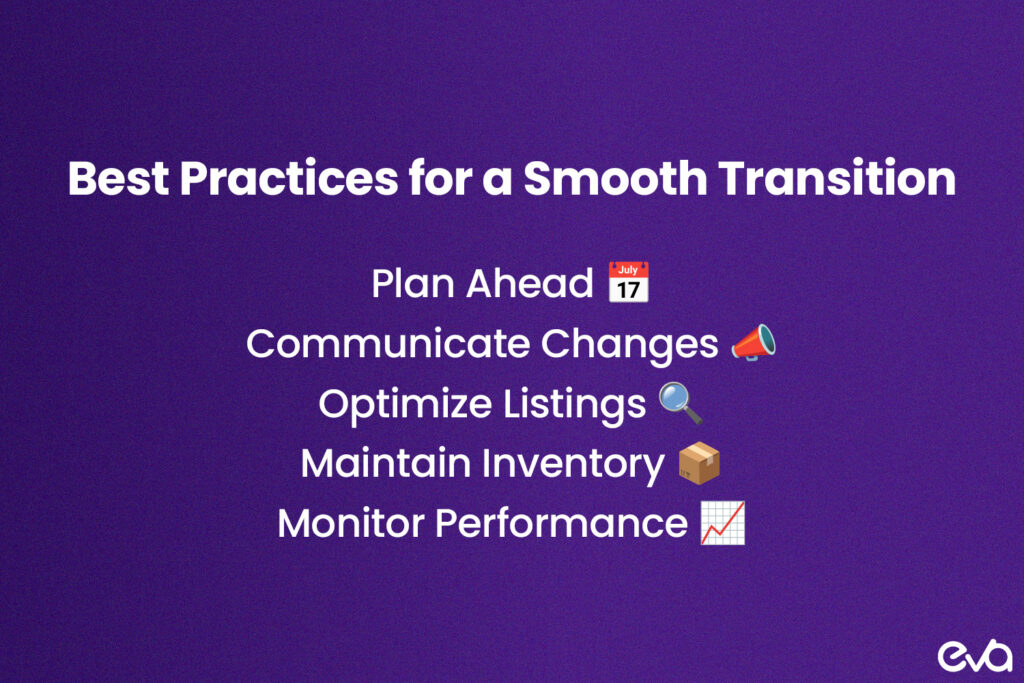
Ensuring a Seamless Customer Experience
During the switch, focus on delivering exceptional service. Monitor stock levels and maintain fast delivery times to keep customer satisfaction high.
Managing Your Pricing Strategy in Seller Central
Leverage Amazon Growth Strategy tools to monitor competitors and adjust your pricing to win the Buy Box.
Common Challenges When Moving from 1P to 3P
Pricing Conflicts and Buy Box Competition
Competing with resellers for the Buy Box can be challenging. Use Amazon PPC Management to increase visibility and secure sales.
Inventory Management Issues
Monitor stock levels and use tools like Amazon FBA Consulting to optimize storage and reduce costs.
Conclusion
Transitioning from Amazon Vendor to Seller is a strategic decision that can significantly impact your brand’s growth and profitability.
By gaining control over pricing, marketing, and customer relationships, you position your brand for sustainable success.
If you’re looking for expert guidance, Eva offers Amazon Account Management, Amazon Brand Management, and other services to ensure a smooth transition and maximize your sales potential.
FAQs
Amazon Vendor (1P) involves selling products directly to Amazon, which then sells them to customers. In contrast, Amazon Seller (3P) allows brands to sell directly to consumers on Amazon’s marketplace, providing greater control over pricing, inventory, and marketing strategies.
Transitioning to Amazon Seller (3P) offers increased control over pricing, enhanced marketing flexibility, and the potential for higher profit margins. It also allows brands to manage customer relationships and brand representation directly.
Eva provides an AI-powered platform integrating inventory management, conversion rates, and profitability metrics. This enables brands to optimize advertising strategies, manage listings, and make data-driven decisions during the Transition.
The Transition involves:
Setting up a Seller Central account.
Listing products.
Managing inventory.
Choosing fulfillment options (FBA or FBM).
Optimizing product listings for better visibility and sales.
Eva’s AI platform analyzes real-time data to optimize Amazon Advertising campaigns, ensuring maximum efficiency and return on investment by considering inventory levels and conversion rates.
Eva offers comprehensive Amazon Listing Optimization services, enhancing product titles, descriptions, images, and keywords to improve search rankings and conversion rates.
Brands can choose between Fulfillment by Amazon (FBA), where Amazon handles storage and shipping, or Fulfillment by Merchant (FBM), where the brand manages its logistics.
Eva’s platform provides advanced Amazon PPC Management tools, allowing brands to create, monitor, and optimize pay-per-click campaigns to drive targeted traffic and increase sales.
Eva’s Amazon SEO Services improve product visibility by optimizing listings with relevant keywords, enhancing search rankings, and driving organic traffic to increase sales.
Eva offers comprehensive Amazon Account Management services, including monitoring account health, managing customer feedback, and ensuring compliance with Amazon’s policies to maintain a positive seller reputation.

